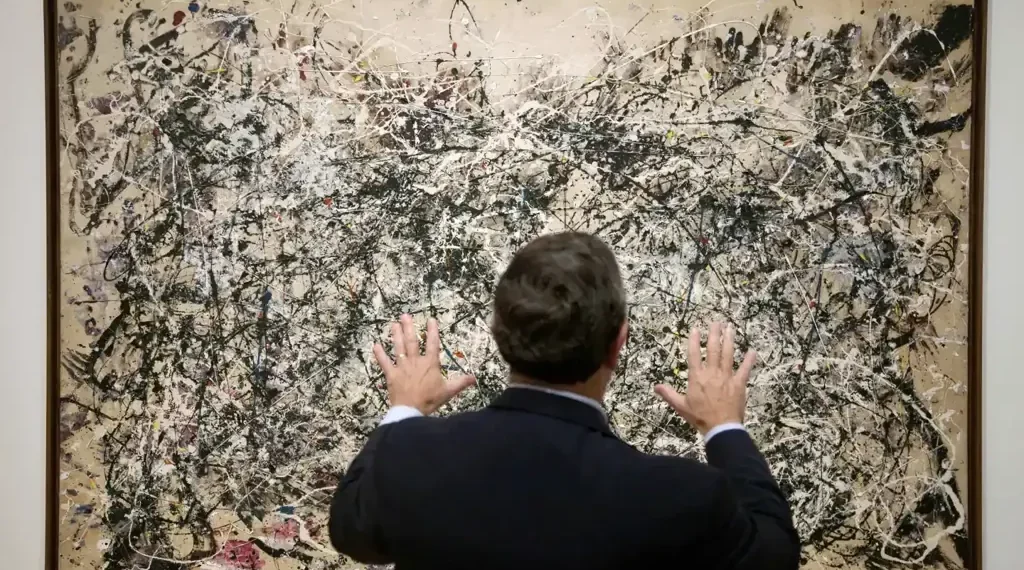Researchers Identify Rare Pigment in Jackson Pollock’s Painting
Published: September-23-2025, 16:45, EDT
A decades-old art mystery has been solved as researchers confirmed that Jackson Pollock used manganese blue, a synthetic pigment, to create the striking turquoise hue in his painting Number 1A, 1948. The discovery offers new insight into the artist’s creative methods and the chemistry behind his work, which remains one of the most studied examples of abstract expressionism.
Pollock’s Signature Style
Pollock’s Number 1A, 1948 is one of the largest canvases he ever produced, stretching nearly nine feet wide. Known for his drip technique, Pollock layered colors in a way that seemed chaotic but was meticulously intentional. The work features bold reds, yellows, and blues, with Pollock’s handprints near the top as a personal signature.
While the reds and yellows in the painting had been identified in earlier studies, the source of the rich turquoise blue had puzzled scientists and conservators for years.
Scientific Methods Unlock the Mystery
To uncover the pigment’s origin, researchers used an advanced technique that involves directing lasers at tiny samples of paint and measuring how the molecules vibrate. This method produced a unique chemical fingerprint, confirming that the pigment was manganese blue.
The study, published in the Proceedings of the National Academy of Sciences, marks the first confirmed use of manganese blue in Pollock’s work.
“It’s really interesting to understand where some striking color comes from on a molecular level,” said Edward Solomon, a Stanford University chemist and co-author of the study.
A Pigment with a Short History
Manganese blue was once popular among mid-20th-century artists and was also used in commercial applications such as coloring swimming pool cement. However, by the 1990s, the pigment was phased out due to environmental concerns.
Gene Hall, a Rutgers University scientist who has previously studied Pollock’s paintings but was not involved in the study, said the findings were convincing. “I’m pretty convinced that it could be manganese blue,” Hall noted.
Beyond Identification: Structure and Conservation
The researchers went further by studying the pigment’s chemical structure to understand why it produces such a vivid shade. This type of analysis not only provides historical insights but also supports conservation efforts, helping museums preserve artworks and detect forgeries.
Pollock’s unconventional methods—pouring paint directly from cans or using sticks to drip color across the canvas—make it easier for scientists to isolate individual pigments in his paintings. Unlike artists who mixed paints on a palette, Pollock left layers of raw color exposed.
Science and Art Intertwined
For the researchers, the process of solving this mystery paralleled Pollock’s own experimental approach. “I actually see a lot of similarities between the way that we worked and the way that Jackson Pollock worked on the painting,” said Abed Haddad, assistant conservation scientist at the Museum of Modern Art.
Pollock himself resisted claims that his work was chaotic, insisting that it was methodical and deliberate. The latest findings underscore that his innovations were not only artistic but also deeply connected to the materials and chemistry available in his time.
This article was rewritten by JournosNews.com based on verified reporting from trusted sources. The content has been independently reviewed, fact-checked, and edited for accuracy, neutrality, tone, and global readability in accordance with Google News and AdSense standards.
All opinions, quotes, or statements from contributors, experts, or sourced organizations do not necessarily reflect the views of JournosNews.com. JournosNews.com maintains full editorial independence from any external funders, sponsors, or organizations.
Stay informed with JournosNews.com — your trusted source for verified global reporting and in-depth analysis. Follow us on Google News, BlueSky, and X for real-time updates.













